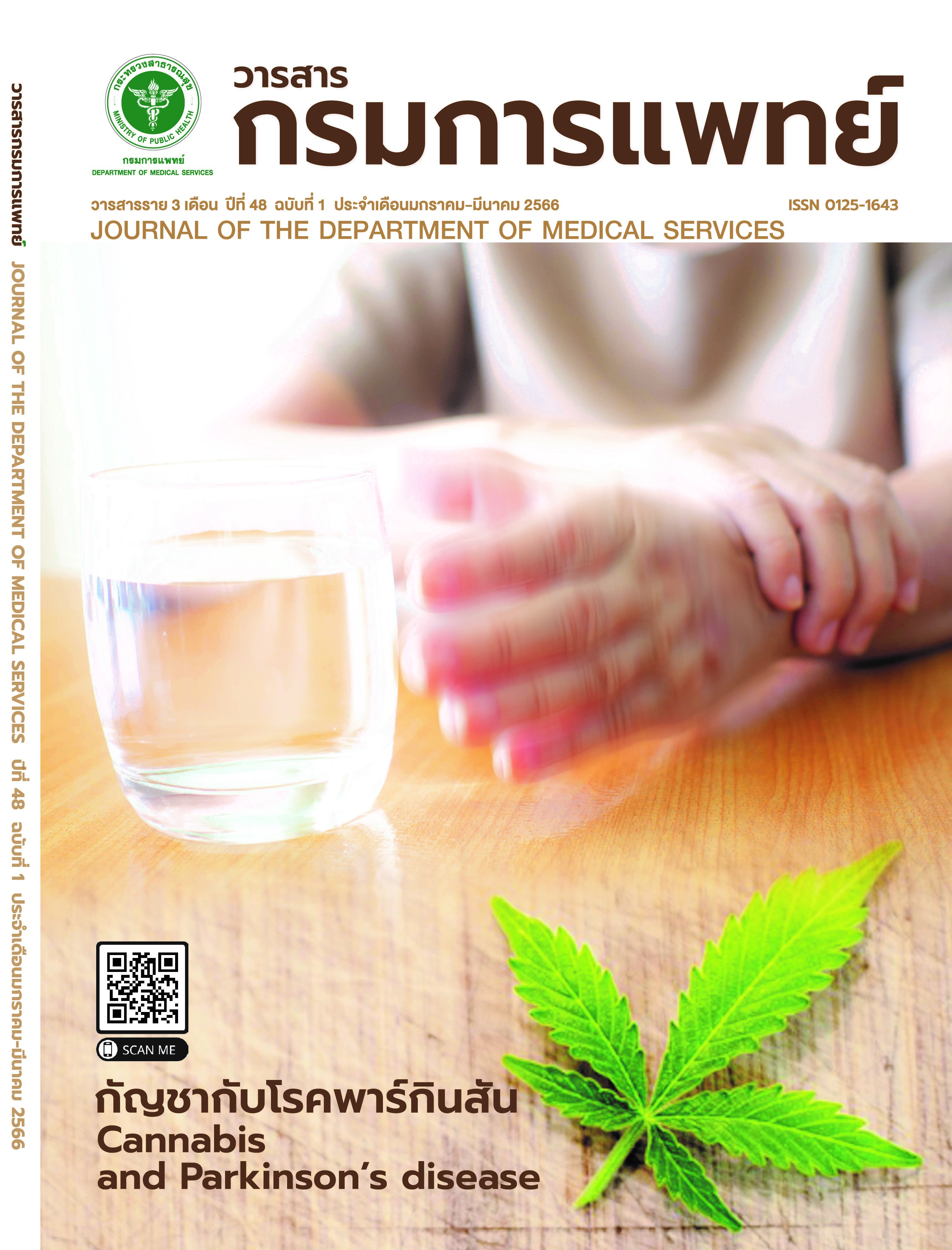Results of Hip Subluxation Prevention Program in Cerebral Palsy Children at Queen Sirikit National Institute of Child Health
Keywords:
Cerebral palsy, Hip subluxation, Hip dislocation, Hip dysplasia, Hip surveillance programAbstract
Background: Hip subluxation is common in children with cerebral palsy, and it can lead to serious complicationssuch as hip pain, limitation of movement, and scoliosis. Hip surveillance programs (early screening and treatment)can reduce the risk of hip dislocation, as well as improve the mobility and quality of life of the CP children. In 2016,QSNICH started the hip surveillance program including preventive and corrective programs. The preventive programcontained early hip x-rays screening, non-surgical treatment, and orthopedic referal as indicated. Objective: Thisstudy aimed to determine the percentage of hip screening before 2 years old and the results of the preventiveprogram to maintain the migration percentage (MP) of less than 40%. Method: Chart reviews of patients visitedwith the first hip x-rays were done from 2015 to 2019. The patients had been followed up for 4 years or until theywere 6 years old. Result: 128 CP children were included during the study period. In 2015, the mean age of patientswho underwent hip screening was 4.83 years old, and 66.67% of the patients had hip x-rays before 2 years old. Afterthe surveillance program was applied, 74.08% of the CP children got the first hip screening before the 2nd year oflife. The average age of hip screening was 3.06 years old. Most of the patients (84.75%) who received the preventiveprogram still had MP below 40% for 1.89 years. Hip posture as 90-degree knee flexion was related to hip migrationprogression. Conclusion: After the implementation of hip surveillance program, the percentage of cerebral palsychildren that had undergone a hip screening before 2 years old was increased. This program prevents hip migrationprogression (MP > 40%) in most patients.
References
Lins LAB, Watkins CJ, Shore BJ. Natural History of Spastic HipDisease. J Pediatr Orthop. 2019; 39:S33-S37.
Huser A, Mo M, Hosseinzadeh P. Hip Surveillance in Childrenwith Cerebral Palsy. Orthop Clin North Am. 2018; 49:181-190.
Reimers J. The stability of the hip in children. A radiologicalstudy of the results of muscle surgery in cerebral palsy. ActaOrthop Scand Suppl. 1980; 184:1-100.
Terjesen T. The natural history of hip development in cerebralpalsy. Dev Med Child Neurol. 2012;54:951-7.
Soo B, Howard JJ, Boyd RN, Reid SM, Lanigan A, Wolfe R, et al.Hip displacement in cerebral palsy. J Bone Joint Surg Am. 2006;88:121-9.
Hägglund G, Lauge-Pedersen H, Wagner P. Characteristicsof children with hip displacement in cerebral palsy. BMCMusculoskelet Disord. 2007; 8:101.
Wynter M, Gibson N, Willoughby KL, Love S, Kentish M,Thomason P, et al. Australian hip surveillance guidelines forchildren with cerebral palsy: 5-year review. Dev Med ChildNeurol. 2015; 57:808-20.
Pruszczynski B, Sees J, Miller F. Risk factors for hip displacementin children with cerebral palsy: systematic review. J PediatrOrthop 2016; 36: 829–33.
Marcström A, Hägglund G, Alriksson-Schmidt AI. Hip pain inchildren with cerebral palsy: a population-based registry studyof risk factors. BMC Musculoskelet Disord. 2019; 20:62.
Shrader MW, Wimberly L, Thompson R. Hip surveillance inchildren with cerebral palsy. J Am Acad Orthop Surg. 2019;27:760-768.
Kentish M, Wynter M, Snape N, Boyd R. Five-year outcome ofstate-wide hip surveillance of children and adolescents withcerebral palsy. J Pediatr Rehabil Med. 2011; 4:205-17.
Hägglund G, Andersson S, Düppe H, Lauge-Pedersen H, Nordmark E,Westbom L. Prevention of dislocation of the hip in childrenwith cerebral palsy. The frst ten years of a population-basedprevention programme. J Bone Joint Surg Br. 2005; 87:95-101.
Hermanson M, Hägglund G, Riad J, Rodby-Bousquet E, Wagner P.Prediction of hip displacement in children with cerebralpalsy: development of the CPUP hip score. Bone Joint J. 2015;97:1441-4.
Parkes J, Hill N, Platt MJ, Donnelly C. Oromotor dysfunction andcommunication impairments in children with cerebral palsy: aregister study. Dev Med Child Neurol. 2010; 52:1113-9.
Connelly A, Flett P, Graham HK, Oates J. Hip surveillance inTasmanian children with cerebral palsy. J Paediatr Child Health.2009; 45:437-43.
Downloads
Published
How to Cite
Issue
Section
License
Copyright (c) 2023 Department of Medical Services, Ministry of Public Health

This work is licensed under a Creative Commons Attribution-NonCommercial-NoDerivatives 4.0 International License.
บทความที่ได้รับการตีพิมพ์เป็นลิขสิทธิ์ของกรมการแพทย์ กระทรวงสาธารณสุข
ข้อความและข้อคิดเห็นต่างๆ เป็นของผู้เขียนบทความ ไม่ใช่ความเห็นของกองบรรณาธิการหรือของวารสารกรมการแพทย์



